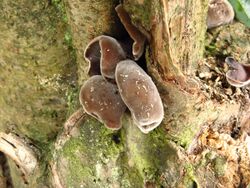Biology:Cloud ear fungus
| Cloud ear fungus | |
|---|---|

| |
| Cloud ear fungus | |
| Scientific classification | |
| Domain: | Eukaryota |
| Kingdom: | Fungi |
| Division: | Basidiomycota |
| Class: | Agaricomycetes |
| Order: | Auriculariales |
| Family: | Auriculariaceae |
| Genus: | Auricularia |
| Species: | A. polytricha
|
| Binomial name | |
| Auricularia polytricha (Mont.) Sacc.
| |
| Synonyms | |
The two above proposed senior synonyms are from mutually-exclusive analyses.[1] | |
| Auricularia polytricha | |
|---|---|
| smooth hymenium | |
| no distinct cap | |
| hymenium attachment is irregular or not applicable | |
| lacks a stipe | |
| spore print is white | |
| ecology is saprotrophic | |
| edibility: choice | |
Cloud ear fungus (Auricularia polytricha, syn. Hirneola polytricha) is an edible jelly fungus. It grows on trees in mountainous regions, is gray-brown in color, and is often used in Asian cooking, especially Chinese cuisine.[2]
Terminology
It is known as Mandarin Chinese: 云耳; pinyin: yún'ěr, lit. "cloud ear"[citation needed], Chinese: 毛木耳; pinyin: máomù'ěr, lit. "hairy wood ear"), and in Japanese it is called ara-ge-ki-kurage (アラゲキクラゲ, lit. "rough-hair-tree-jellyfish").It is also known as wood ear fungus, wood fungus, ear fungus, or tree ear fungus, an allusion to its rubbery ear-shaped growth. In Europe, it is frequently misidentified as "Jew's ear", and "Jelly ear", which are very closely related but distinct species.
In Hawaii, it is known as pepeiao which means "ear"[3] In Southeast Asia, it is known as bok née in local English (from the Hokkien 木耳 bo̍k-ní) and is used in the salad kerabu bok nee. In Indonesia and Malaysia, it is called jamur kuping, meaning "the ear mushroom", and in the Philippines , the locals call it tenga ng daga, meaning "rat's ear", due to its appearance. In Chinese cooking, it is often referred to as "Black Treasure".[2] In New Zealand, it is known as hakeke by Māori.[4]
Description
Fruit body resupinate or pileate, loosely attached, laterally and sometimes by a very short stalk, elastic, gelatinous; sterile surface dark yellowish brown to dark brown with greyish brown bands, hairy, silky. Hymenium smooth, or wrinkled, pale brown to dark brown to blackish brown with a whitish boom. Hairs thick-walled, up to 0.6 mm long. Basidia cylindrical, hyaline, three-septate, 46–60 × 4–5.5 μm with 1–3 lateral sterigmata; sterigmata 9–15 × 1.5–12 μm. spores, hyaline, reniform to allantoid, 13–16 × 4–5.5 μm, guttulate.[5]
Habitat and distribution
This section is missing information about elsewhere around the world. (September 2021) |
Auricularia polytricha is widely distributed in moist-deciduous to wet evergreen forests of the Western Ghats, Kerala, India. This species occurs in clusters on rotting branches and twigs and on decaying stumps and logs.[5]
Uses
Auricularia polytricha is usually sold in dried form, and needs to be soaked in water before use. While almost tasteless, it is prized for its slippery but slightly crunchy texture, and its potential nutritional benefits.[6] The slight crunchiness persists despite most cooking processes.[7] Auricularia polytricha is coarser than Auricularia auricula-judae, and is more likely to be used in soups rather than stir-fries.[8]
Māori traditionally cooked wood ear fungus by steaming in an earth oven and eating with sow thistle and potatoes.[9]
According to Chinese medicine practitioners, eating dried and cooked wood ear can have health benefits for people with high blood pressure or cancer, and can prevent coronary heart disease and arteriosclerosis.[2] It may also be effective in reducing LDL cholesterol and aortic atherosclerotic plaque, as demonstrated in a study on rabbits.[10] This fungus is used in Cantonese desserts.
A cup of dry cloud ear fungus contains 19.6 grams of dietary fiber.[11]
Related fungi
- Auricularia auricula-judae, the "Judas' Ear fungus", a closely related species, is also used in Asian cuisine and has been considered a culinary alternative to Cloud Ear fungus.[12]
- Snow fungus, Tremella fuciformis, another edible fungus which is white but otherwise superficially similar in appearance, has similar culinary and medicinal uses, but is actually a parasitic species in another class of fungi.
See also
References
- ↑ New Zealand Organisms Register: Auricularia polytricha, Nomenclature.
- ↑ 2.0 2.1 2.2 "Cuisine - Food - Cloud ear fungus". China Daily. 28 February 2011. http://www.chinadaily.com.cn/life/2011-12/29/content_14352868.htm.
- ↑ Elizabeth Speith. "Auricularia polytricha (Auriculariaceae) - HEAR species info". Hear.org. http://www.hear.org/species/auricularia_polytricha/.
- ↑ Stephen Brightwell. "Feasting on Fungi". https://www.nzgeo.com/stories/feasting-on-fungi/.
- ↑ 5.0 5.1 Mohanan C. (2011). Macrofungi of Kerala. Kerala, India: Kerala Forest Research Institute. pp. 597. ISBN 978-81-85041-73-5.
- ↑ Smith, Lana Billings. "The nutritional benefits of wood ear fungus". http://www.livestrong.com/article/510629-the-nutritional-benefits-of-wood-ear-mushrooms/.
- ↑ "Why wood ear fungus should be a part of your daily meals". http://organicolivia.com/2014/11/04/why-wood-ear-black-fungus-should-be-a-staple-in-your-diet/.
- ↑ So, Yan-kit (16 January 2015) (in en). Yan-Kit's Classic Chinese Cookbook. Penguin. p. 248. ISBN 9781465439758. https://books.google.com/books?id=YEO3BQAAQBAJ&pg=PA248.
- ↑ Riley, Murdoch (1988). Maori Vegetable Cooking: Traditional and Modern Methods. New Zealand: Viking Sevenseas NZ Ltd. p. 6.
- ↑ Fan, YM; Xu, MY; Wang, LY; Zhang, Y; Zhang, L; Yang, H; Wang, P; Cui, P (1989). "The effect of edible black tree fungus (Auricuaria auricula) on experimental atherosclerosis in rabbits". Chinese Medical Journal 102 (2): 100–5. PMID 2505974.
- ↑ "Fungi, Cloud ears, dried". https://ndb.nal.usda.gov/fdc-app.html#/food-details/168581/nutrients.
- ↑ "Archived copy". http://wsmbmp.org/proceedings/3rd%20international%20conference/Vol%202/MUSHCONF.PDF.[full citation needed]
External links
| Wikimedia Commons has media related to Auricularia auricula-judae. |
Wikidata ☰ Q2479145 entry
de:Judasohr


